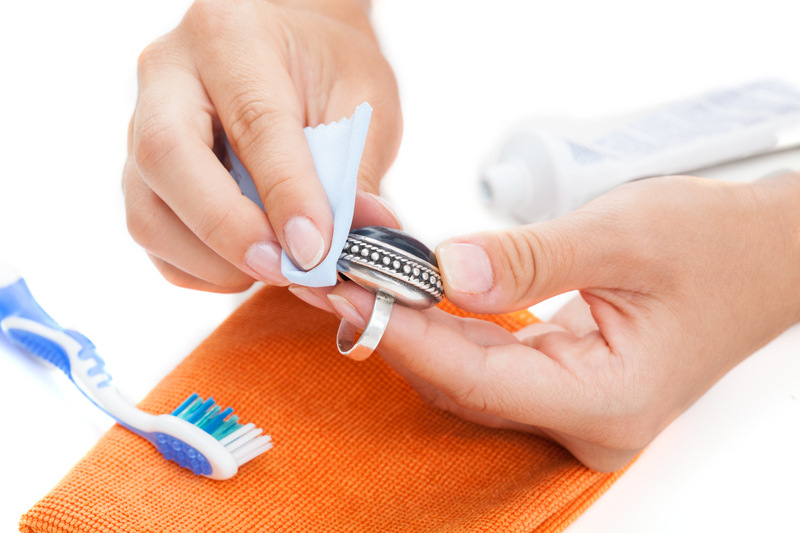Discover How to Clean Mould from Window Sills
Posted on 11/06/2025
Discover How to Clean Mould from Window Sills: The Ultimate Guide
_Mould on your window sills is an unwelcome guest in any home. Not only does it look unsightly, but it can also affect air quality and potentially trigger health issues. If you're looking to get rid of this persistent problem, you're in the right place! In this comprehensive article, we'll discover how to clean mould from window sills, offering safe, effective, and lasting solutions._

What Causes Mould to Grow on Window Sills?
Mould is a type of fungus that thrives in moist, warm environments. Window sills, particularly those in kitchens and bathrooms, are high-risk areas because:
- Condensation: Frequent temperature changes near windows create condensation, leading to damp surfaces that foster mould and mildew growth.
- Poor Ventilation: Limited airflow allows humidity to linger, providing the perfect breeding ground for black mould or green mildew.
- Leaky Windows: Water ingress from damaged or aging window seals can wet the sill, encouraging fungal spores to multiply.
- Organic Debris: Dust and dirt gather in window sills, acting as food sources for mould.
_Effective mould removal is about more than just appearances; tackling the issue helps safeguard your household's indoor air quality and protects your property from decay and staining._
Why You Need to Remove Mould from Window Sills
- Health Impact: Mould spores can cause allergies, asthma attacks, and respiratory problems, especially in children, the elderly, or those with compromised immune systems.
- Property Damage: Prolonged exposure to mould can damage paint, timber, and plaster, leading to costly repairs.
- Unpleasant Odors: Mould and mildew often produce a musty smell that permeates a room.
- Reduced Home Value: Visible signs of mould can seriously detract from a property's appeal and market value.
How to Identify Mould on Window Sills
Not all stains on window frames are caused by mould. Here's how to recognize the presence of window sill mould:
- Color: Mould is usually black, green, brown, or grey in color.
- Texture: It often appears velvety, fuzzy, or slimy.
- Spread: Small spots can quickly develop into larger patches.
- Odor: Look for a damp, musty smell near the affected area.
Identifying the signs early makes it easier to tackle the problem before it persists or spreads to other household areas.
Preparing to Remove Mould from Window Sills
Safety Precautions Before You Start
Cleaning mould from window sills involves disturbing fungal spores, which can be hazardous if inhaled. Always take the following precautions:
- Wear Protective Gloves: Rubber or disposable gloves prevent direct contact with mould and cleaning chemicals.
- Use a Face Mask: An N95 respirator or similar mask helps to avoid inhaling airborne spores.
- Protective Eyewear: Safety goggles shield your eyes, especially when using strong cleaners.
- Ventilate the Area: Open windows and doors where possible to improve airflow.
- Old Clothing/Apron: Wear garments you can easily wash or dispose of after cleaning.
_These steps help ensure safe and effective mould removal from window sills and frames._
Step-by-Step Guide: How to Clean Mould from Window Sills
Gather Your Cleaning Supplies
- Spray bottle (for applying cleaning solution)
- Soft brush or old toothbrush
- Microfiber cloths or paper towels
- Protective gloves, mask, and goggles
- Cleaning solution: Choose one of the following:
- White vinegar (natural and effective)
- Hydrogen peroxide (Kills mould and mossy growths)
- Bleach (very effective, but use with caution as it can damage some materials)
- Commercial mould remover or mildew cleaner
- Bowl of warm water
- Disposable bag (for used wipes and paper towels)
Method 1: Natural Mould Cleaning Solution with Vinegar
- Empty the area: Remove any objects from your window sills.
- Spray undiluted white vinegar: Fill a spray bottle with plain vinegar and liberally mist it onto the mould.
- Let it sit: Allow the vinegar to soak for at least 60 minutes. This breaks down mould structure, making it easier to clean.
- Scrub: Use a soft brush or toothbrush to gently loosen mould and mildew from the surface.
- Wipe clean: Use a damp microfiber cloth to remove loosened residue.
- Repeat if needed: For stubborn stains, reapply vinegar and scrub again.
- Dry thoroughly: Wipe the area with a dry cloth to remove any moisture.
Method 2: Mould Removal with Bleach
- Ventilate the area and wear proper protection as bleach gives off strong fumes.
- Mix solution: Combine 1 part household bleach to 10 parts water in a spray bottle.
- Apply generously to the mouldy surface until thoroughly wet.
- Wait 10-15 minutes: Allow the solution to fully penetrate and disinfect.
- Scrub and wipe: Use your brush, then a clean damp cloth to remove all traces.
- Dry completely. Consider running a fan or dehumidifier to hasten drying.
Method 3: Using Commercial Mould & Mildew Remover
- Choose a reputable commercial mould cleaner (available in supermarkets or hardware stores).
- Follow all label instructions regarding application, dwell time, and rinse requirements.
- Ventilate well and wear gloves.
- Scrub and wipe away debris.
These products often contain surfactants and biocides that penetrate deeper, speeding up the removal of stubborn black mould from window sills.
Method 4: Natural Alternatives (Baking Soda & Tea Tree Oil)
- Baking Soda Paste: Mix baking soda and water into a paste, spread onto mould patches, leave 15 minutes, scrub, and wipe away.
- Tea Tree Oil Spray: Add 1 teaspoon of tea tree oil to 1 cup of water, spray on surface, let sit, then wipe clean. Tea tree oil naturally inhibits fungal regrowth.
_Natural remedies are ideal for households with sensitivities or where children and pets are present._
How to Clean Mould from uPVC and Wooden Window Sills
Cleaning Mould from uPVC Window Sills
- uPVC is less porous than wood, making it easier to clean.
- Use a vinegar spray, leave for 30-60 minutes, then wipe with a non-scratch sponge.
- A diluted bleach solution can be used for heavy stains but rinse thoroughly to avoid long-term damage to the plastic.
- Polish with a specialist uPVC cleaner for a bright finish (optional).
Cleaning Mould from Wooden Window Sills
- Be gentle: Excess water can damage wood or lift the paint/varnish.
- Use vinegar or a specialized wood-safe mildew cleaner.
- Scrub lightly and dry thoroughly; consider using a hairdryer or dehumidifier.
- Inspect for signs of rot; persistent black spots may indicate damage beneath the surface, requiring repair or replacement.
How to Prevent Mould on Window Sills in the Future
_Cleaning mould is half the battle--not letting it come back is just as important._ Here are some practical, long-term mould prevention tips:
- Reduce Humidity: Use a dehumidifier or run an extractor fan, particularly in kitchens and bathrooms.
- Ventilate Regularly: Open windows whenever possible to allow fresh air to circulate.
- Wipe Condensation: Mop up water droplets on windows and sills to deny mould the moisture it loves.
- Repair Leaks: Address any window or roof leaks promptly.
- Declutter Window Sills: Remove any unnecessary items that might trap moisture or collect dust.
- Use Anti-Mould Paint: Consider repainting sills with a fungicidal/anti-mould paint for added protection.
Regular Cleaning Routine
- Dust and wipe window sills weekly with a mild detergent solution.
- Treat any signs of condensation or damp as soon as possible.
- Schedule deep cleaning every season or as needed, especially after prolonged wet weather.
FAQ: How to Clean Mould from Window Sills
What's the best way to get rid of black mould on window sills?
_The best method combines a potent cleaning agent like white vinegar or a commercial mould remover, thorough scrubbing, and complete drying. Always test on a small area first._
Can vinegar remove mould for good?
White vinegar kills around 80% of mould species, including most commonly found on window sills. For persistent or recurring issues, follow up with preventative measures.
Is it safe to clean mould yourself?
_Small areas (less than 1 square meter) can typically be cleaned safely using basic household supplies and proper protection. For large outbreaks or if you have allergies, consult a professional._
Why does mould keep returning to my window sills?
_Recurrent mould is usually due to unresolved sources of dampness (e.g. condensation, leaks, inadequate ventilation). Address the underlying moisture problem to achieve lasting results._
Is bleach safe for wooden window frames?
Bleach can strip finishes and stain wood. For wood surfaces, stick to vinegar, baking soda, or specialist wood-safe products.

When to Call a Professional Mould Remediation Service
- If the mould covers a large area (over 1 square meter)
- There are signs of rot or structural damage
- Mould keeps returning despite all attempts to remove it
- You or household members experience persistent illness
_Professionals have access to industrial-grade cleaning agents and equipment to deal with severe or recurring infestations._
Conclusion: Keep Window Sills Clean and Mould-Free
_Cleaning mould from window sills doesn't have to be a chore. By following this guide--from effective mould removal steps to long-term prevention--you can maintain a fresh, healthy, and inviting home. Remember, the sooner you tackle window sill mould, the easier it is to remove. Keep your windows bright, your indoor air pure, and your living space beautiful!_
- Spot mould on your window sills? Act quickly with these proven cleaning methods!
- Need more tips? Bookmark this guide to always keep your home mould-free and sparkling clean.
If you found this article on how to clean mould from window sills helpful, share it with friends and family--everyone deserves a fresher home!



